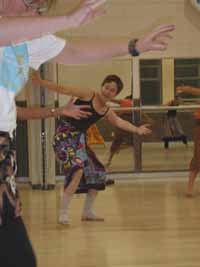Moments in Movement
The floor is awhirl with people dressed in bright sarongs dancing to the beat provided by live drummers. This swirl of activity is part of the African dance classes taught in conjunction with Modern dance classes.
Students of all types and backgrounds are encouraged to join Audrey Eisenhauer and Suzann Kienast as they teach modern dance on Tuesday nights and African dance on Thursdays.
According the The Encyclopedia of Dance Modern dance developed at the turn of the century, primarily in the United States and Germany and is known for being experimental and iconoclastic. Its pioneers each rebelled against the rigid formalism of classical ballet and against the triteness of show dancing. They based their works on personal experience, using their bodies as instruments to express emotions such as passion, fear, joy or grief. Rather than adhering to a set form and a limited range of gestures, as in ballet, the dancer created form as an outgrowth of his or her own communicative impulses. Modern dance seeks to inspire audiences to a new awareness of inner and outer realities.
“Modern dance is a dance form with a specific technique that originated from ballet,” Kienast said. “African dance came from Africa. It’s the ethnic, traditional dance. For a lot of people, African is easier because most of the movements are more natural and people are able to do it. It’s not as grounded in technique.”
“I like this class because it is a break in the day and a fun way to exercise,” said Jennifer Poe, a freshman class member. “My favorite part is letting go and moving in creative ways. The instructors are both wonderful and very knowledgeable.”
“Anyone and everyone can do modern and African,” Eisenhauer said.
“If you try it and don’t like it, that’s fine,” Kienast said. “But, you might discover something new that you really enjoy.”
“My favorite part is the freedom and release in the movement,” she said. “You tap into something that most don’t on a daily basis. It’s like therapy.”
“[Modern dance] kept me sane through college,” Eisenhauer said. “It just feels really good to me. I sometimes come home from work and think, ‘I don’t want to go to class,’ but I always feel great when I go. It’s a good release.”
“I get to move my body in different ways that are not structured,” Kienast said. “Modern and African dance doesn’t discriminate against body types or age.”
“You’re not locked into specific movements. You can do anything,” Eisenhauer said.
Both Eisenhauer and Kienast have had many years of dance experience, training and performance.
Eisenhauer started taking tap and jazz when she was 8 and continued through high school. She discovered modern dance in a physical education course.
“I just really liked the expressive and creative aspects of it,” she said.
She said she started taking classes in college and began to perform frequently. She began teaching and earned a dance minor from Humboldt University in California. Toward the end of college, she started choreographing. Eisenhauer performed in California many times, including main-stage performances and has performed with many dance projects in Utah including Dancers with Day Jobs.
Kienast said she started training in modern jazz when was young and continued this training as well as drill team through high school.
“Then I discovered modern,” she said.
She started taking classes at Utah State University and performed with the university before the program was cut.
She has performed many times in Logan and Salt Lake City with the Valley Dance Ensemble, Dancers with Day Jobs and projects at the Rose Wagner Theatre.
Kienast said she started taking African about four years ago. She has trained in San Francisco, Salt Lake City and at national workshops. She also teaches children’s creative movement.
Referring to future goals at USU, Kienast said, “Our goal is to have a performance this spring semester … we would like to involve students in the class and other groups from the valley.”
Students who are interested in the modern and African classes can come try them on Tuesday or Thursday nights from 8 to 9:30 p.m. in the HPER Building, Room 215. The cost is $40 for the semester.

Suzann Kienast leads her class in an African dance last Thursday. (Joe Rowley )

